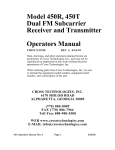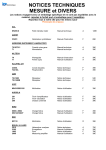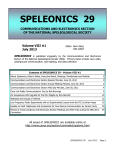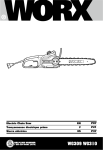Download Cross Technologies 455T Specifications
Transcript
Model 455R, 455T Composite MTS/BTSC Subcarrier Receiver and Transmitter Operators Manual Rev 2.2 6/25/98 Data, drawings, and other material contained herein are proprietary to Cross Technologies, Inc., and may not be reproduced or duplicated in any form without the prior permission of Cross Technologies, Inc. When ordering parts from Cross Technologies, Inc., be sure to include the equipment model number, equipment serial number, and a description of the part. CROSS TECHNOLOGIES, INC. 6170 SHILOH ROAD ALPHARETTA, GEORGIA 30005 (770) 886-8005 FAX (770) 886-7964 WEB www.crosstechnologies.com E-MAIL [email protected] Model 455R, 455T Composite MTS/BTSC Subcarrier Receiver and Transmitter Operators Manual TABLE of CONTENTS SECTION TITLE PAGE Warranty........................................................4 OPERATORS SAFETY CONSIDERATIONS................5 1 GENERAL INFORMATION ................................. 7 1-1. INTRODUCTION ........................................................... 7 1-2. SPECIFICATIONS .......................................................... 7 1-3. SAFETY CONSIDERATIONS ............................................ 7 1-4. GENERAL DESCRIPTION ................................................ 10 2 INSTALLATION ............................................ 11 2-1. INTRODUCTION ........................................................... 11 2-2. INITIAL INSPECTION .................................................... 11 2-3. PREPARATION FOR USE ................................................ 11 2-4. Power Requirements ..................................................... 12 2-5. Line Voltage Selection ................................................... 12 2-6. Power Cable ............................................................... 13 2-7. OPERATING ENVIRONMENT ........................................... 13 2-8. RACK MOUNTING ........................................................ 13 2-9. REMOTE & ALARM CONNECTIONS .................................. 13 2-10. Remote Control Interface Information ................................ 14 2-11. VIDEO BASEBAND CONNECTIONS ................................. 14 2-12. COMPOSITE/STEREO/SAP/PRO/MONITOR CONNECTIONS.... 15 2-13. VIDEO FILTERING ....................................................... 16 2-14. REPACKAGING ........................................................... 17 455 Operation Manual Page 2 6/23/98 TABLE of CONTENTS SECTION 3 TITLE PAGE OPERATION ................................................ 18 3-1. INTRODUCTION ........................................................... 18 3-2. APPLYING POWER ........................................................ 18 3-3. CONTROL SWITCHES .................................................... 19 3-4. STATUS CHANGES ....................................................... 19 3-5. ALARM INDICATIONS ................................................... 21 3-6. TROUBLESHOOTING .................................................... 22 4 ADJUSTMENTS and OPTIONS ........................... 26 4-1. INTRODUCTION ........................................................... 26 4-2. RECOMMENDED TEST EQUIPMENT ................................. 26 4-3. TRANSMITTER FRONT PANEL ADJUSTMENTS .................. 27 4-4. Level Adjustment (IF) ................................................... 27 4-5. Deviation Adjustment (DEV) ........................................... 28 4-6. Use of the Overmodulation Indicator .................................. 30 4-7. RECEIVER FRONT PANEL ADJUSTMENTS ........................ 30 4-8. Squelch Adjustment ...................................................... 31 4-9. Composite Level Adjustment ........................................... 32 4-10. TRANSMITTER INTERNAL OPTIONS ............................... 32 4-11. RECEIVER INTERNAL OPTIONS ..................................... 32 4-12. Input High Pass Filter .................................................. 33 455 Operation Manual Page 3 6/23/98 WARRANTY This Cross Technologies product is warranted against defects in material and workmanship for one year from the date of shipment. During this period Cross Technologies will either repair or replace, at its option, products which prove to be defective. To obtain service under this warranty, this product must be returned to Cross Technologies at its address. Buyer shall pay all shipping charges to Cross Technologies, and Cross Technologies shall pay all charges for return shipment to buyer. When this product is to be returned from outside the United States, buyer shall pay all shipping charges, taxes, duties or other reasonable or necessary costs to transport the product safely in both directions. LIMITATIONS AND EXCLUSIONS This warranty shall not apply to defects resulting directly or indirectly from any of the following: Improper or inadequate maintenance. User-supplied interfacing or connected equipment. Operation beyond the specifications of the unit or under severe environmental conditions. Improper facility preparation or maintenance. No other warranty is expressed or implied. Cross Technologies specifically disclaims any implied warranties of merchantability or fitness for any particular purpose. Under no circumstances shall Cross Technologies be liable for any incidental, indirect or consequential damages or losses, whether or not Cross Technologies has any advance notice of the possibility of such damages. Correspondence: CROSS TECHNOLOGIES, INC. 6170 Shiloh Road, Alpharetta, GA 30005 Telephone (770) 886-8005 E-mail [email protected] FAX (770) 886-7964 455 Operation Manual Page 4 6/23/98 OPERATORS SAFETY CONSIDERATIONS General The general safety information in this documentation is for operating and servicing personnel. Specific warnings and cautions will be found throughout the manual where they apply and may or may not appear here. Safety Symbols ___________ _ WARNING _ ___________ WARNING symbols indicate a condition, practice or procedure that, if not properly performed or adhered to, could result in personal injury or loss of life. CAUTION CAUTION symbols indicate a condition, practice or procedure that, if not properly performed or adhered to, could result in damage to the equipment or other property. Before Applying Power CAUTION Verify that the voltage selection on the power receptacle matches the line voltage and the proper fuse is installed. See Section 2. ___________ _ WARNING _ ___________ This equipment is grounded through the grounding conductor of the power cord supplied with the unit. To avoid electrical shock, plug the power cord into a properly wired receptacle. An uninterruptible safety earth ground must be provided from the main power source to the equipment via the power cord. Grounding one conductor of a two conductor wiring system or cord is not sufficient protection. 455 Operation Manual Page 5 6/23/98 OPERATORS SAFETY CONSIDERATIONS (Cont'd.) ___________ _ WARNING _ ___________ Danger From Loss of Protective Ground Upon loss of the protective ground connection, all accessible conductive parts can render an electrical shock. Do Not Remove Covers or Panels To avoid personal injury or shock, equipment should not be operated without covers or panels. Servicing Servicing instructions are for the use of qualified servicing personnel only. Some adjustments described in this manual are performed with power applied to the equipment and the cover removed. To avoid dangerous shock, only qualified service personnel should perform maintenance. LCD Display Module The LCD Display Module mounted in the front panel is fragile. Care should be taken not to break the exposed glass panel. If broken, extreme caution should be used to avoid cuts from sharp edges. If the liquid crystal material touches your skin or clothes, wash it off immediately using soap and plenty of water. Do not allow any of the liquid crystal material to get in your mouth. 455 Operation Manual Page 6 6/23/98 Section 1 - GENERAL INFORMATION 1-1. INTRODUCTION. This manual contains information necessary for the installation, operation, testing and alignment of the Model 455 FM Subcarrier. The documentation for this product is divided into five sections as described below. Section 1.General Information: provides general information about this equipment, circuit description and specifications. Section 2.Installation: provides installation information including initial inspection, installation and repackaging the equipment. Section 3.Operation: provides information about front panel checks and settings. Section 4.Adjustment & Options: provides information to adjust the equipment, and to select the various options. 1-2. SPECIFICATIONS. The specifications are listed in Table 1-1. These are performance standards to which the Model 455 is aligned and tested. 1-3. SAFETY CONSIDERATIONS. Safety information, relating to installation, testing, etc. is found throughout this manual. Please refer to OPERATORS SAFETY CONSIDERATIONS at the beginning of this manu CROSS TECHNOLOGIES INC. DEV IF PROGRAM ALARM A B EXECUTE CROSS TECHNOLOGIES INC. SQUELCH AUDIO PROGRAM ALARM A B EXECUTE FIGURE 1-1 Model 455 Subcarrier Transmitter and Receiver 455 Operation Manual Page 7 6/23/98 TABLE 1-1 - SPECIFICATIONS System Characteristics: Subcarrier frequency range......Frequency agile from 1.0 MHz to 9.99 MHz in 10 kHz steps Frequency response..............±0.1 dB from 20Hz to 70kHz; ±0.5 dB from 70kHz to 120kHz Total harmonic distortion..........<0.05% at 1 kHz (De-emphasized, 30kHz bandwidth) Long term stability (6 months)....±0.1 dB at 25°C; ±0.25 dB, 0-50°C Channel spacing (minimum).......280 kHz for narrow deviation; 600 kHz for wide deviation Remote control input...............User selectable for on/off or alternate frequency selection Power requirement.................115/230 VAC (47-63 Hz) <20 VA Storage temperature range..........-40°C to +70°C Operating temperature range........0°C to +51°C Mechanical dimensions............44.4mm (1.75")H x 483mm (19")W x 381mm (15")D, each Modulator Characteristics: Nominal deviation for 1V rms (2.828V p-p) inputs: Input Deviation Setting Wide Narrow Composite.............................±150.0kHz ±73kHz Stereo..................................±113.0kHz ±55kHz SAP......................................±30.8kHz ±15kHz Pro.........................................±6.2kHz ±3kHz 455 Operation Manual Page 8 6/23/98 TABLE 1-1 - SPECIFICATIONS (Cont'd.) Subcarrier output level.................75 to 300 mV P/P (adj.) Output impedance......................Bridging (≥3 kΩ) to 75Ω line Front panel adjustments/settings.............Deviation Subcarrier Level Subcarrier Frequency Deviation Range Wide/Narrow Channel On/Off Remote Control Mode / Alternate Frequency Front panel visual indications................Subcarrier Frequency Alarm and On/Off Status Overmodulation Remote Active Connector type.......................(7) BNC Female plus 5 position modular terminal strip for remote and alarms Demodulator Characteristics Composite output level............1.0 V rms for ±150 kHz deviation (wide) or ±73 kHz deviation (narrow) Subcarrier input level...............1 mV to 500 mV P/P Input impedance.................Bridging (≥4 kΩ) to 75Ω line Front panel adjustments/settings.............Squelch Level Composite Output Level Subcarrier Frequency Channel On/Off Remote Control Mode / Alternate Frequency Front panel visual indications.................Subcarrier Frequency Alarm and On/Off Status Remote Active Connector type......................(3) BNC Female plus 5 position modular terminal strip for remote and alarms 455 Operation Manual Page 9 6/23/98 1-4. GENERAL DESCRIPTION. The 455 Composite Subcarrier System is engineered to provide a transparent path for the complete MTS/BTSC composite signal over any video microwave system. With its extremely low distortion (less than 0.05% at 1kHz), flat frequency response from 20Hz to 120kHz, and outstanding long-term stability, the 455 has almost no measurable effect on stereo audio performance. Both the modulator and the demodulator are fully frequency synthesized and microprocessor controlled for ease of operation and the ultimate in versatility. All of the critical operating parameters, as well as any alarm conditions, are displayed on the front panel LCD. Any operating frequency from 1 MHz to 9.99 MHz can be selected from the front panel. Also selected from the front panel is a choice of "wide" or "narrow" deviation settings. The wide setting is used to provide optimum signal-to-noise performance for STL applications, while the narrow setting provides BTSC broadcast standard compatibility which (with the unit set to 4.50 MHz) can be used for direct feeds to cable systems or low power transmitter facilities. In spite of this convenient user interface, a number of safeguards make it nearly impossible to change the settings of the unit by accident. A built in non-volatile memory device retains the most recent configuration of the unit during temporary power outages or even prolonged storage without power. A remote control input is provided which can be used to either turn the channel on or off, or to switch the operating frequency. This feature is extremely useful for redundant or backup system configurations, and, like all of the 455's features, can be easily configured from the front panel. The 455 demodulator incorporates Tectan's patented threshold extension FM detector. This unique circuit permits the 455 to flawlessly track the incoming FM signal under severe noise conditions which render other receivers useless. This detector design is also inherently stable with respect to both amplitude and phase, without resorting to complicated automatic modulation control circuits. The video baseband is combined with the subcarrier signals in the transmitter by a low component count passive directional coupler. This circuit has been designed to put virtually no load on the video line (≥3 KΩ), allowing multiple units to be "daisy-chained" without adversely affecting the signals on the baseband. The low component count and passive nature of this circuit provide excellent protection against disruption of the baseband due to component failure or loss of power in the 455. 455 Operation Manual Page 10 6/23/98 Section 2 - INSTALLATION 2-1. INTRODUCTION. This section contains instructions for installing and interfacing the Model 455 Composite MTS/BTSC FM Subcarrier. Included are initial inspection procedures, power and grounding requirements, line voltage selection, interface connections and instructions for repackaging the equipment. 2-2. INITIAL INSPECTION. ___________ _ WARNING _ ___________ In the event that any portion of the outer enclosure of the unit has been damaged, a hazardous electrical shock condition may exist. In this case, do not apply power to the unit, or attempt to perform electrical tests. Inspect the shipping container for damage. The shipping container and cushioning material should be kept until the contents of the shipment have been checked for completeness and the equipment has been checked mechanically and electrically. This equipment was carefully inspected both mechanically and electrically before shipment. It should be free of mars and scratches and in perfect electrical order upon receipt. If there is mechanical damage or defect due to shipment, notify the carrier immediately. Keep the shipping material for the carrier's inspection. In the event of mechanical damage, or if the equipment does not pass electrical performance tests, notify the Cross Technologies office immediately. The warranty statement is located in the front of this manual. 2-3. PREPARATION FOR USE. Each unit is shipped from the factory with the following strapping options: Factory Setting Optional Setting Highpass filter (Receive) .. IN (Video present) .. OUT (no Video) Power ........................105-130 Vac .......... 210-250 Vac To change the line voltage setting of your unit, please refer to Paragraph 2-5. To change the other settings, please refer to Section 5. 455 Operation Manual Page 11 6/23/98 2-4. Power Requirements. The Model 455 requires a power source of 105V-130V 50-60Hz or 210V-250V 50-60Hz. Power consumption is: Transmitter.................. 24 VA maximum. Receiver..................... 20 VA maximum. 2-5. Line Voltage Selection. CAUTION Before connecting ac power to this equipment, make sure it is set to the line voltage of the power source. Also ensure that the common connection of the power outlet is connected to a protective earth contact. ___________ _ WARNING _ ___________ Line voltage selection is made at the ac plug-in receptacle on the rear of the shelf. This should be done by trained service personnel only. To avoid electrical shock, make sure the power cord is disconnected before changing the voltage selection pc board. Before connecting this device to the power source, verify that a protective earth ground connection is provided through the grounding conductor of the power cord. The protective ground connection through the power cord grounding conductor is essential for safe operation. The Model 455 is shipped from the factory with the line voltage selection set for 105-130 Vac. If it is necessary to change the line voltage selection, access to the voltage selection pc board can be accomplished by: *Removing the ac cord. *Open the cover door, rotate the fuse-pull to the left, removing the fuse. *Remove the pc board. Select operating voltage by orienting the pc board to position desired voltage on top-left side. Push board firmly into module slot. *Rotate fuse-pull back into normal position and re-insert fuse into holder, using caution to select the proper fuse value. 455 Operation Manual Page 12 6/23/98 Fig. 2.1 AC Connector 2-6. Power Cable. In accordance with safety standards, this equipment is supplied with a three conductor cable. When connected to an appropriate power line outlet, this cable grounds the equipment cabinet. 2-7. OPERATING ENVIRONMENT. The operating environment should be within the following limitations: Temperature........................ 0 °C to +50 °C Humidity........................... 95% maximum non-condensing Altitude........................... 3050 meters (10,000 ft.) ASL 2-8. RACK MOUNTING. The Model 455 is intended for rack mounting in a rack having an EIA standard width of 482.6 mm (19 inches). It is shipped from the factory with the mounting brackets set for flush mounting. Optionally the mounting brackets can be reversed for extended mounting (5 inches). Four 12-24 screws are required for mounting in the rack. 2-9. REMOTE & ALARM CONNECTIONS. Remote control and alarm connections are made at the 5 position terminal block on the rear of the equipment. A thin-bladed flat screwdriver is required. Connections are made as marked on the rear panel. Terminals will accept wire sizes up to 12 AWG maximum. 455 Operation Manual Page 13 6/23/98 BTSC COMPOSITE MONITOR BASE BAND LOOP THRU INPUT OUTPUT BTSC COMPOSITE STEREO IN (XMT) OUT (RCV) SAP I NPUTS PRO N O C O N M C R M T ALM FIGURE 2-2 455 Rear Panel 2-10. Remote Control Interface Information. The 455 remote control input is capable of switching the unit to an alternate configuration which the user has pre-programmed (see Section 3-4 for set-up information). The alternate configuration can differ from the normal configuration in any or all of the parameters which can be set using the front panel switches (ON/OFF, Frequency, WIDE/NARROW Deviation). The remote input has a 10kΩ nominal internal pull-up resistor to +5V. An input of less than +2V selects REMOTE, and an input of greater than +3V selects LOCAL. Because of the internal pullup resistor, an open circuit condition also selects LOCAL. The connecting circuit should be capable of sinking at least -200µA to assure a logical low condition to select remote. Most commercial logic devices (including TTL & CMOS) are compatible with this input. CAUTION Do not exceed the following maximum ratings for the remote control input: MAXIMUM INPUT VOLTAGE: +60 VDC MINIMUM INPUT VOLTAGE: -60 VDC Although the remote input has excellent high frequency noise immunity due to an internal filter, low frequency noise on long lines may cause inadvertent switching. Shielded cables are recommended for all applications, or, if long distances or high noise environments are expected, balanced line drivers and receivers should be used. 2-11. VIDEO BASEBAND CONNECTIONS. Video baseband connections are BNC connectors on the rear of the shelf. A detailed description of the connections are: Transmitter: Input - Video input from video source. If video is not used this port should be terminated with 455 Operation Manual Page 14 6/23/98 75Ω. In multiple- unit operation, the input of units after the first is connected to the output of the preceding unit. Output - Composite output to microwave or satellite transmitter. In multiple unit operation, the output of all but the last unit connects to the input of subsequent units. Receiver: Input - Composite input from microwave or satellite receiver. In multiple-unit operation, the input of units after the first is connected to the output of the preceding unit. Output - Video output to monitor or video receiving equipment. If video is not used, this port should be terminated with 75Ω. In multiple unit operation, the output of all but the last unit connects to the input of subsequent units. 2-12. COMPOSITE/STEREO/SAP/PRO/MONITOR CONNECTIONS. These connections are BNC connectors on the rear of the shelf. A detailed description of the connections are: Transmitter: BTSC Composite - InThis 75Ω input is designed to accept the output of a BTSC composite generator which has built-in SAP and PRO channel generators, or which provides combining inputs for separate generators. The 100% modulation level for this input is 1V RMS (2.8V p-p). If this input is used, the alternate inputs listed below should not be used. Stereo Input - This 75Ω input is designed to accept the output of a BTSC stereo generator which does not have built-in SAP and PRO channel generators or which does not have combining inputs for separate generators. The 100% modulation level for this input is 1V RMS (2.8V p-p). SAP Input - This 75Ω input is designed to accept the output of a separate SAP Channel generator. The 100% modulation level for this input is 1V RMS (2.8V p-p). PRO Input - This 75Ω input is designed to accept the output of a separate Professional Channel generator. The 100% modulation level for this input is 1V RMS (2.8V p-p). 455 Operation Manual Page 15 6/23/98 Composite Monitor - This output connector provides a monitor point for the combined modulation signal resulting from the various input signals. The output impedance is 75Ω and should be terminated with 75Ω when measurements are being made. BTSC COMPOSITE MONITOR BASE BAND LOOP THRU INPUT OUTPUT BTSC COMPOSITE STEREO IN (XMT) OUT (RCV) SAP I NPUTS PRO N O C O N M C R M T ALM FIGURE 2 -3 455 TX and RX Connectors (RX has BTSC Inputs plugged) Receiver: BTSC Composite Out - This 75Ω output is the recovered MTS/BTSC composite signal from the receiver. The output should be connected to equipment having an input impedance of 75Ω; if the connecting equipment is high impedance, a 75Ω termination should be added at the end furthest from the 455. 2-13. VIDEO FILTERING. The video source should be adequately filtered to prevent harmonics or other high frequency components from interfering with the low level subcarrier signals in the upper part of the baseband. If the video signal source does not include a suitable lowpass filter, a video lowpass filter should be added to the system between the video source and the first subcarrier transmitter. At the receive site, video quality is improved by using a filter to remove the high frequency subcarrier signals prior to the video equipment. If an adequate video lowpass filter is not included in the video receiving equipment, one may be added between the last subcarrier receiver and the video equipment. 455 Operation Manual Page 16 6/23/98 2-14. REPACKAGING. If the equipment is to be returned to Cross Technologies for any reason, care should be taken in packaging. Call Cross Technologies for a Return Material Authorization (RMA) number. Enclose documents detailing reason for return, return address, name and telephone number of contact person. Original Packaging. It is preferable to use the original packaging if it was retained. Use care in packing, sealing and marking the container. Other Packaging. The general instructions below should be followed if re-packaging is done with commercially available material. 1. A strong container should be used. Minimum requirement would be of singlewall construction, 200 pound test material. 2. The equipment should be wrapped in plastic with 3 to 4 inches of shock absorbing material on all sides. Anti-static material is preferred but not mandatory. 3. Seal the container securely. Be sure the container is properly marked. If the unit is being returned for repair: Please refer to Section 3-6, Troubleshooting, before returning the unit to the factory for repair. If the problem cannot be remedied locally, please include as much information as possible about the nature of the problem you are experiencing, as well as information about your system configuration, including frequencies and levels of the various signals on the baseband. 455 Operation Manual Page 17 6/23/98 Section 3 - OPERATION 3-1. INTRODUCTION. This section describes operation of the front panel controls. There are three operator switches, the LCD display and an alarm indicator. All functions for the equipment are controlled by these components. The functions are: 1.Turn the channel "on" or "off". 2.Set the frequency of the channel. 3.Select the "wide" or "narrow" deviation mode. 4.Setup these parameters for the remotely activated configuration. Alarm indications appear on the LCD display but are not controlled by the operator. Both hardware and software have been designed to make reprogramming as "tamper proof" as possible. The Program/Execute switch is recessed so it will not inadvertently be operated. All program changes must start with the operation of the Program/Execute switch and must also end with the operation of the Program/Execute switch. If this sequence is not followed, none of the changes will take effect. If programming is initiated and no operator action takes place for approximately 12 seconds (before the final press of the Program/Execute switch) the display will revert to its previous status and you will need to start over. 3-2. APPLYING POWER. NOTE:The last status of a unit is retained even when power is removed. When power is restored, the unit will return to it's previous settings. When power is first applied, the LCD display goes through four steps. 1.The LCD goes black to show all segments are functioning. 2.The display will show the unit model number. __________________ __________________ _455 Transmitter _ or _455 Receiver _ __________________ __________________ 455 Operation Manual Page 18 6/23/98 3.The software version will be displayed. __________________ _Software Rev #.#_ __________________ 4.The present status of the channel is shown. The unit is now operational and ready for any changes the operator may desire. 3-3. CONTROL SWITCHES. 1.Program/Execute. Any change to the programming of the unit must be initiated by pressing the Program/Execute switch and completed by pressing the Program/Execute switch. 2.Cursor Movement - Horizontal. This switch is mounted so its movement is horizontal and moves the cursor left or right. 3.Vertical Switch. This switch is mounted so its movement is vertical and has two functions: A)During frequency changes, the vertical movement will raise or lower the frequency in the direction of the arrows. B)For other functions such as on/off or compandor disable, the vertical switch will alternately turn the function on or off regardless of the direction operated. 3-4. STATUS CHANGES. At any time during the modification process, if you have made a mistake and do not wish to save the changes you have made, do not press the Program/Execute switch; simply do nothing for approximately 12 seconds, and the system will return to the normal operating mode. To modify the status of a channel: 1.Operate the Program/Execute switch. The display will read: __________________ _MODIFY LOCAL _ __________________ 455 Operation Manual Page 19 6/23/98 Pressing the Up/Down switch (in either direction) will toggle the display to: __________________ _MODIFY REMOTE _ __________________ When the display indicates the configuration (local or remote) to be modified, press the Program/Execute switch. 2.Status of the selected configuration will be displayed. For example: __________________ _L 6.60MHz ON _ __________________ The display consists of: An initial letter indicates Local or Remote. The current frequency setting. The current ON/OFF status. 3.By using the horizontal rocker switch the cursor can be moved left or right to either the ON/OFF position or to any digit of the frequency. A.If ON/OFF is selected, the status can be modified by operating the vertical switch. This will alternately turn the channel on or off. B.If changes are desired in the frequency, move the cursor to the digit that you wish to modify. By using the vertical switch, that digit can be raised or lowered by the direction of the arrow. The cursor can then be moved to another digit and the action repeated until the desired frequency is displayed. NOTE: The modified frequency and ON/OFF condition will not become effective until the final operation of the Program/Execute switch described in the next paragraph. To prevent interruption of other channels when a frequency change takes place, the 455 automatically mutes the carrier until the phase locked loop frequency synthesizer has stabilized at the new frequency. 455 Operation Manual Page 20 6/23/98 4.Operate the Program/Execute switch. The display will now show the deviation setting (WIDE/NARROW): __________________ __________________ _WIDE DEVIATION _ or _NARROW DEVIATION_ __________________ __________________ If you wish to make a change, operate the vertical switch to toggle the status. When the display indicates the desired condition, press the Program/Execute switch a final time. At this time the changes you have made will become the new settings for the channel. 3-5. ALARM INDICATIONS. An alarm condition for either channel will: Illuminate the alarm indicator (the indicator will blink in the case of a transmitter overmodulation alarm), Indicate the alarm status on the LCD display, The following will occur for all alarm conditions except transmitter overmodulation alarm: Cause a form C relay closure to appear at the terminal block on the rear of the shelf for remote indication. Mute the output of the channel (composite in the case of a receiver, or the subcarrier in a transmitter). Alarms are: Transmitter: CXR ALMif the carrier frequency deviates beyond predetermined limits. AFC ALMif the synthesizer is out of lock. CXR AFCif both alarms are present. OVERMODif the combined composite input signals cause the internal deviation limiter to activate (due to either excessive input level or misadjustment of the front panel DEViation control). 455 Operation Manual Page 21 6/23/98 Receiver: CXR ALM upon a drop in incoming carrier level beyond the squelch setting or the RF/IF section of the receiver is defective. AFC ALM if the incoming carrier is off frequency or if the frequency determining elements of the receiver are defective. CXR AFC if both alarms are present. CAUTION An annoying remote alarm can be disabled by turning the channel "off". If this is done there will be no alarm condition active to remind maintenance personnel there is a problem. The channel may be brought on-line by someone unaware of the existing problem. 3-6. TROUBLESHOOTING. In the event of difficulty with the 455 Subcarrier System, the following list of possible causes should be reviewed prior to contacting the factory for repair. In the event that factory repair is deemed necessary, please refer to Section 2-14, Repackaging, for information on returning the unit. Audio sound quality not acceptable. Symptoms could include one or more of the following: High distortion Poor frequency resp. Sounds noisy Transmitter set to "wide" deviation with receiver set for "narrow" deviation. Combined composite signal at the transmitter inputs may be excessive. Transmitter DEViation control misadjusted. Receiver may also indicate an AFC alarm intermittently. 455 Operation Manual Page 22 6/23/98 Audio is noisy, but sounds normal in other respects. Transmission path noise may be excessive. Check other system components, RF power, and antenna pointing. In non-video systems, if the subcarrier frequency is less than about 4.5MHz, the high pass filter in the receiver may not be set OUT. (See Section 5-17.) Audio sounds noisy. Tones, chirps, buzz, etc may also be present. Channel spacing may be too close. The 455 requires 600 kHz ("wide") or 280kHz ("narrow") between adjacent center frequencies to meet all specifications. At closer spacings some of these symptoms may appear. The subcarrier channel may be co-located with one of the harmonics of a video signal component (e.g., colorburst). Shift subcarrier frequencies and reevaluate. Total baseband power may be too high, leading to intermodulation products. Reduce the level of the subcarriers and/or video and reevaluate. In systems with video, the high pass filter in the receiver may be set OUT. (See Section 5-17.) 455 Operation Manual Page 23 6/23/98 Composite level and/or carrier deviation too high or low. LCD display blank. LCD display shows: NV Memory Error Receiver LCD display indicates a CXR alarm. Verify correct equipment impedances and terminations. Loss of power. Possible causes include blown fuse, incorrect line voltage selection, etc. (See Section 2-5.) A checksum error was found after reading the nonvolatile memory device. The unit may still be used (press the Program/Execute switch to proceed) but should be returned for repair as soon as convenient since a power interruption may cause loss of the unit's programmed settings. Receiver may be set to an incorrect frequency, or the transmit site may not be operating on the specified frequency. Receiver SQUELCH adjustment may need to be changed. (See Section 5-7) The subcarrier transmitter for the specified frequency may not be operating, or may be at a reduced carrier level. 455 Operation Manual Page 24 6/23/98 Receiver LCD display indicates an AFC alarm. Any of the situations described above for a CXR alarm may, under some conditions, also cause an AFC alarm. The receiver may be tuned to a wide deviation channel which it is unable to track. LCD display is garbled or inconsistent with normal operation. Ribbon cable connecting display circuit board to the main circuit board may have come loose due to rough handling in shipping. See Section 5-13 to remove cover. Carefully align cable and press firmly into socket on main circuit board. Socketed integrated circuit devices may have come loose due to rough handling in shipping. See Section 5-13 to remove cover. Firmly press these devices to seat them in their sockets (particularly U1, U6, & U9 which are located behind and to the right of the display. 455 Operation Manual Page 25 6/23/98 Section 4 - ADJUSTMENTS and OPTIONS 4-1. INTRODUCTION. This section describes operator adjustments and the selection of the internal options. For a discussion of the microprocessor-controlled functions (Channel ON/OFF, FREQUENCY and compandor IN/OUT) please refer to Section 3-4. For a discussion of line voltage selection, please refer to Section 2-5. The operator adjustments are located on the front panel on both the transmitter and receiver. The transmitter adjustments consist of subcarrier level and deviation trims. The receiver adjustments consist of squelch threshold and composite output level trims. The only internal option on the 455 is the selection of the receive high pass filter. This option is set at the factory to IN, and should only changed if the system is used below 4.0 MHz in the absence of video. 4-2. RECOMMENDED TEST EQUIPMENT. Note: The equipment listed below comprises all of the test equipment mentioned in this section. It is not necessary to have all of these items on hand to perform the adjustments. Refer to each subsection for the specific items needed. Item Manufacturer & Model Audio Analyzer ........................... HP 8903B Modulation Monitor ...................... Marconi TF2300A AC Voltmeter ............................. Fluke 8920A Spectrum Analyzer ........................HP 8552B/8553B Frequency Selective VM.................. HP 3586C Oscilloscope ............................... Tektronix 2235 75Ω 1% BNC Termination .............. Any 25Ω 1% 50Ω to 75Ω series adapter .... Any Equivalent equipment is acceptable. The specifications of the alternate instrument should always be significantly better than the desired accuracy of the measurement to be made. 455 Operation Manual Page 26 6/23/98 4-3. TRANSMITTER FRONT PANEL ADJUSTMENTS. NOTE:Prior to setting levels be sure transmitter is ON and set to proper frequency. See Section 3. 4-4. Level Adjustment (IF). Determine the desired subcarrier level for your specific system. The 455 Transmitter subcarrier level can be adjusted over the range of 75 mV to 300 mV p/p (approx. -8 TO -20 dB, 75Ω). A. Level Adjustment Without Video or Other Channels. If it is possible to set the subcarrier level with all other signals (i.e., video and all other subcarriers) removed from the baseband, the desired subcarrier level may be set directly using an oscilloscope or wideband AC voltmeter. If it is necessary to adjust the subcarrier level in a "live" circuit with video and/or other subcarriers present, proceed to the method described in Paragraph B., below; otherwise, proceed as follows: 1.Connect the BASEBAND INPUT BNC connector of the 455 Transmitter to a suitable 75Ω termination. 2.Connect the BASEBAND OUTPUT BNC connector of the 455 Transmitter to the measuring instrument (either an oscilloscope or wideband AC voltmeter). If the measuring instrument has a high impedance input (normally the case), this line should also be terminated with a suitable 75Ω termination. 3.Adjust the IF (subcarrier level) screwdriver adjustment on the front panel for the proper system level. B. Level Adjustment With Video and/or Other Channels. When other signals (such as video or other subcarrier channels) are present on the baseband, it is necessary to use a measuring instrument that can be tuned to the desired signal (such as a spectrum analyzer, frequency selective level meter, or modulation meter with level measuring capability). Proceed as follows: 1.If the measuring instrument has a high impedance input, connect it to the baseband signal at any convenient point after the insertion of the subcarrier to be adjusted. If the 455 Operation Manual Page 27 6/23/98 measuring instrument has a low impedance (i.e., 75Ω or 50Ω) it is necessary to connect the instrument to an isolated monitor point in order to prevent the additional load presented by the low impedance input from affecting the level to be measured. 2.With the measuring instrument properly tuned to the frequency of the channel to be adjusted, set the IF (subcarrier level) screwdriver adjustment on the front panel for the proper level for your system. 4-5. Deviation Adjustment (DEV). The 455 Transmitter is designed to operate with a maximum peak deviation of the subcarrier of 150 kHz (300 kHz peak-to-peak) in the "wide" mode, and 73 kHz (146 kHz peak-to-peak) in the "narrow" mode. A built-in limiter limits peak subcarrier deviation to approximately 168 kHz in the "wide" mode, and 82 kHz in the "narrow" mode. This deviation is a result of the entire composite signal consisting of L+R, L-R, pilot, SAP, and PRO channels. If your stereo generator has a built-in Bessel null calibration tone, it may be used to accurately set the deviation of the 455 Transmitter in the "narrow" deviation mode. This mode may be used even if you intend to use the "wide" deviation setting in your application. Switching from "narrow" to "wide" will maintain the deviation calibration within approximately one percent. The inputs on the 455 are designed to accept 2.828V p-p signals for 100% modulation levels. The deviations assigned to the various inputs are as follows: Input Deviation Setting Wide Narrow Composite........................... ±150.0kHz ±73kHz (L+R, pilot, L-R, SAP, PRO) Stereo.............................. ±113.0kHz ±55kHz SAP.................................. ±30.8kHz ±15kHz PRO................................... ±6.2kHz ±3kHz (L+R, pilot, L-R) If your BTSC stereo generator can be adjusted to provide the required signal level (2.828V pp), it is recommended that the 455 DEV control be left unchanged from the factory setting, and any adjustments be made at the stereo generator. 455 Operation Manual Page 28 6/23/98 The front panel DEV adjustment is provided to compensate for minor variations in incoming composite signal strength, and is not intended to provide for operation at deviations other than the 455's specified deviation. The deviation may be accurately set using either a modulation meter or a spectrum analyzer; choose the method you find most suitable. A. Deviation Adjustment Using a Modulation Meter. 1.If the modulation meter has a high impedance input, connect it to the baseband signal at any convenient point after the insertion of the subcarrier to be adjusted. If the measuring instrument has a low impedance (i.e., 75Ω or 50Ω) it is necessary to connect the instrument to an isolated monitor point in order to prevent the additional load presented by the low impedance input from affecting the levels of the signals on the baseband (this level change has no direct effect on the adjustment of subcarrier deviation, and may be ignored if there are no active receive sites that may be adversely affected). 2.Connect an audio signal generator to both the LEFT and RIGHT channel inputs of your BTSC stereo generator. The flat (no pre-emphasis) inputs should be used. The output of the stereo generator should be connected to the appropriate input of the 455. Set the signal generator to provide a 1 kHz test signal at a 100% modulation level at both inputs. The pilot should be switched off for this procedure, and the SAP and PRO channels should also be OFF. 3.Tune the modulation meter to the frequency of the 455 Transmitter. Adjust the front panel screwdriver adjustment DEV until the modulation meter indicates a peak deviation reading of ±25 kHz ("narrow" mode) or ±51.37 kHz ("wide" mode). B. Deviation Adjustment Using a Spectrum Analyzer. 1.If the spectrum analyzer has a high impedance input, connect it to the baseband signal at any convenient point after the insertion of the subcarrier to be adjusted. If the measuring instrument has a low impedance (i.e., 75Ω or 50Ω) it is necessary to connect the instrument to an isolated monitor point in order to prevent the additional load presented by the low impedance input from affecting the levels of the signals on the baseband (this level change has no direct effect on the adjustment of subcarrier deviation, and may be ignored if there are no active receive sites that may be adversely affected). 2.Connect an audio signal generator to both the LEFT and RIGHT channel inputs of your BTSC stereo generator. The flat (no pre-emphasis) inputs should be used. The output of the stereo generator should be connected to the appropriate input of the 455. Set the signal 455 Operation Manual Page 29 6/23/98 generator to provide a 10.396 kHz test signal at a 100% modulation level at both inputs. The pilot should be switched off for this procedure, and the SAP and PRO channels should also be OFF. 3.Temporarily disconnect the audio signal generator. Tune the spectrum analyzer to the frequency of the 455 subcarrier. Set the 455 Transmitter to the "narrow" deviation mode. The spectrum analyzer should be set for a scan width of not greater than 20 kHz per horizontal division, and not less than 5 kHz per horizontal division, and the bandwidth should be no greater than 3 kHz. Verify that the desired carrier is clearly visible at the exact center of the analyzer screen. Adjust the gain/attenuation settings of the analyzer so that the peak of the carrier is near the top of the screen, and the vertical resolution is 10 dB per division. Reconnect the audio signal generator. Sidebands of the carrier frequency should be visible at 10.396 kHz intervals on the screen. The center (carrier) signal may or may not be visible, depending on the existing adjustment of the front panel DEV control. Adjust the front panel screwdriver adjustment DEV for a minimum level (1st Bessel null) at the center (carrier) frequency. You have now adjusted the deviation for exactly 25kHz peak (50kHz peak-to-peak). If you intend to use the 455 system in the "wide" deviation mode, change the transmitter to "wide", and change the audio generator to 9.306 kHz. If necessary, slightly readjust the DEV control for a minimum level (2nd Bessel null) at the center (carrier) frequency. The deviation is now set to 51.37 kHz peak (102.74 kHz p-p). 4-6. Use of the Overmodulation Indicator. In normal system use, activation of the overmodulation indicator (OVERMOD alarm) provides a direct indication that the DEViation control is adjusted too far in the clockwise direction. The overmodulation indicator is triggered by the deviation limiter circuit which is set at approximately ±168 kHz in the "wide" mode, and ±82 kHz in the "narrow" mode. The deviation limiter is designed to prevent the 455 from interfering with adjacent channels in the event of an excessive input signal, and should not be activated under normal operating conditions. 4-7. RECEIVER FRONT PANEL ADJUSTMENTS. NOTE:Prior to setting levels be sure receiver is ON and set to proper frequency. See Section 3. 455 Operation Manual Page 30 6/23/98 4-8. Squelch Adjustment. A.Tune the receiver to a compatible active channel. Presence of an Alarm indication and a CXR ALM display may indicate one or more of the following conditions: 1) No carrier is being received. 2) Squelch adjusted improperly. 3) The carrier receiver is malfunctioning. Whenever there is a CXR ALM (regardless of cause) there should be no audio output from the receive channel with the alarm. B.Squelch is factory set to operate if the incoming subcarrier amplitude drops below 25 mV p/p. If you wish to adjust the squelch threshold for your unique receive site conditions, or if you are using subcarrier levels of less than 50 mV p/p, proceed as follows: 1.If the CXR ALM is displayed, adjust SQUELCH counterclockwise until the Alarm extinguishes. 2.With the Alarm off, adjust the SQUELCH clockwise until the Alarm just lights. This is the receiver squelch threshold for a valid carrier. 3.Turn the transmit subcarrier OFF or tune the receiver to an unused channel (i.e. no subcarrier within 600 kHz). 4.IMPORTANT - COUNT TURNS THIS STEP: Turn the SQUELCH counterclockwise until the CXR ALM just extinguishes due to RF noise. 5.Turn the SQUELCH control clockwise one-half the number of turns counted in Step 4. 6.Return to an operating channel. The receiver is now adjusted to squelch at a level halfway between the operating carrier and the RF noise floor. 455 Operation Manual Page 31 6/23/98 4-9. Composite Level Adjustment. A.Connect a high impedance AC Voltmeter across the BTSC Composite Out line. The audio equipment that will normally be connected to this line should remain connected while performing this measurement; if for any reason the level must be set in the absence of the connecting equipment, terminate the line with a precision 75Ω termination. B.Have a 455 transmitter site send a continuous tone of 1 kHz on both channels as follows: connect an audio signal generator to both the LEFT and RIGHT channel inputs of the BTSC stereo generator. The flat (no pre-emphasis) inputs should be used. The output of the stereo generator should be connected to the appropriate input of the 455. Set the signal generator to provide a 1 kHz test signal at a 100% modulation level at both inputs. The pilot should be switched off for this procedure, and the SAP and PRO channels should also be OFF. C.Use the AUDIO screwdriver control on the front panel to adjust the receiver output to 342.5 mv rms (968.6 mv p-p). 4-10. TRANSMITTER INTERNAL OPTIONS. There are no internal options on the 455 Transmitter. 4-11. RECEIVER INTERNAL OPTIONS. The internal options are selected with jumper plugs on the internal printed circuit board, and require removal of the top cover plate of the units. ___________ _ WARNING _ ___________ Unplug the power cord from the equipment before removing any cover plates. Failure to do so could result in a hazardous electrical shock, and/or damage to the equipment. Replace all cover plates prior to restoring power to the equipment. The top cover plate is held in place by 11 flat head phillips machine screws, 2 of which pass through the top edge of the front panel. After removing these screws, carefully remove the top cover plate by tilting the rear edge up slightly and sliding it out from under the top edge of the front panel. 455 Operation Manual Page 32 6/23/98 4-12. Input Highpass Filter. The 455 Receiver input circuitry includes a highpass filter that is designed to prevent high level video signals at the bottom of the baseband from overloading sensitive sections of the receiver. In applications where video is present on the baseband, this filter should always be strapped IN. In applications without video, where the entire baseband is dedicated to subcarriers, the filter should be jumpered in the OUT position. The input highpass filter selection is made with P8. P8 is located directly in front of the Baseband Loop-Thru OUT connector at the rear center of the circuit board. The jumper positions (looking from the front of the unit) are: J3 J1 J4 J2 P8 OUT IN OUT IN Figure 4.1 P8 Settings for High Pass Filter IN J3 J1 J4 J2 P8 OUT IN OUT IN Figure 4.1 P8 Settings for High Pass Filter OUT 455 Operation Manual Page 33 6/23/98










































